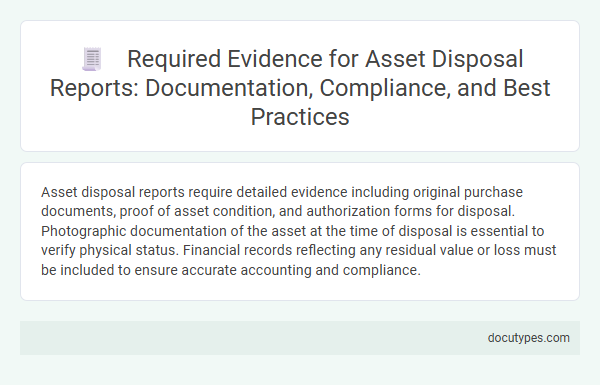Asset disposal reports require detailed evidence including original purchase documents, proof of asset condition, and authorization forms for disposal. Photographic documentation of the asset at the time of disposal is essential to verify physical status. Financial records reflecting any residual value or loss must be included to ensure accurate accounting and compliance.
Introduction to Asset Disposal Reporting
What is the required evidence for asset disposal reports? Asset disposal reporting demands precise documentation to ensure compliance and accurate financial tracking. Your report should include proof such as disposal authorization, valuation records, and confirmation of asset transfer or destruction.
Importance of Documentation in Asset Disposal
| Aspect | Details |
|---|---|
| Required Evidence | Asset disposal reports require documentation such as disposal authorization forms, asset transfer records, proof of asset destruction or sale, financial reconciliation statements, and final approval signatures to ensure transparency and compliance. |
| Importance of Documentation | Proper documentation in asset disposal serves multiple critical functions. It provides a clear audit trail, supports regulatory compliance, verifies the legitimacy of the disposal process, helps prevent asset misappropriation or fraud, and facilitates accurate financial reporting by reflecting asset value changes. |
| Key Documentation Types | Disposal approval forms, physical disposal evidence (photos or certificates), asset write-off records, third-party disposal agreements, and updated asset registers. |
| Outcome | Well-documented asset disposal reports improve organizational accountability, ensure adherence to internal policies and legal requirements, and enhance stakeholders' confidence in asset management processes. |
Key Regulatory Compliance Requirements
Asset disposal reports require precise documentation to meet key regulatory compliance requirements. You must provide detailed records including the asset's description, disposal method, and authorization evidence. Maintaining accurate proof ensures adherence to financial and legal standards, preventing potential audits or penalties.
Essential Evidence for Asset Disposal Audits
Essential evidence for asset disposal audits includes detailed documentation verifying the disposition process and compliance with company policies. This evidence ensures the accuracy and legitimacy of the recorded asset removal from company books.
Supporting documents such as disposal authorization forms, asset condition reports, and proof of sale or destruction are critical. These records provide auditors with concrete proof that disposals were carried out appropriately and transparently.
Types of Documents Needed for Asset Disposal
The required evidence for asset disposal reports includes various types of documents that verify the proper removal and valuation of the asset. Key documents include disposal authorization forms, asset transfer or sale agreements, and asset condition or inspection reports. Supporting paperwork such as approval signatures, valuation assessments, and proof of destruction or sale enhances the accuracy and compliance of the disposal report.
Best Practices for Maintaining Asset Disposal Records
Maintaining thorough asset disposal records ensures compliance and helps prevent financial discrepancies. Clear documentation supports accurate reporting and auditing processes.
Best practices for maintaining asset disposal records include:
- Retain Original Disposal Documentation - Keep all records such as disposal certificates, sales agreements, or donation receipts to verify the asset's final disposition.
- Document Asset Identification Details - Record asset tags, serial numbers, and descriptions to precisely track the items being disposed of.
- Record Authorization and Approval - Ensure disposal forms include signatures from authorized personnel to validate the legitimacy of the disposal transaction.
Common Challenges in Asset Disposal Documentation
Asset disposal reports require thorough evidence such as disposal forms, approval records, and proof of asset removal to ensure compliance and accurate record-keeping. Proper documentation verifies that assets are disposed of according to company policies and regulatory standards.
Common challenges in asset disposal documentation include incomplete records, missing signatures, and discrepancies between reported and actual asset conditions. These issues can lead to audit discrepancies and potential financial losses. Ensuring detailed and accurate documentation requires diligence and consistent verification processes to avoid these pitfalls for your organization's asset management.
Templates and Checklists for Asset Disposal Reports
Templates and checklists streamline the process of compiling necessary evidence for asset disposal reports. They ensure accuracy, consistency, and compliance with regulatory standards.
- Standardized Templates - Provide a structured format to capture all essential details such as asset identification, disposal method, and approval signatures.
- Comprehensive Checklists - Help verify that all required documentation, including valuation reports and disposal authorizations, are included.
- Audit Trail Support - Ensure thorough documentation to facilitate internal reviews and external audits with clear evidence of each disposal step.
Your use of these tools enhances the credibility and completeness of asset disposal reports.
Role of Stakeholders in Asset Disposal Compliance
Asset disposal reports require accurate and verifiable evidence to ensure compliance with regulatory standards. Stakeholders play a crucial role in providing and validating this evidence.
- Ownership Documentation - Stakeholders must provide clear proof of asset ownership to support the disposal process.
- Disposal Approval Records - Management and compliance teams are responsible for approving disposal actions and documenting authorizations.
- Verification of Asset Condition - Technical staff or auditors verify the physical state and usability of assets before disposal.
What Is the Required Evidence for Asset Disposal Reports? Infographic

